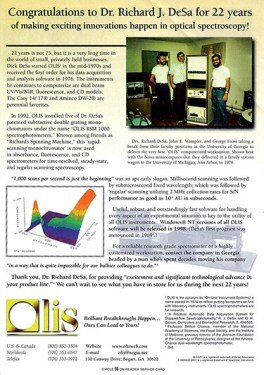The Facts About Spectrophotometers Revealed
Table of ContentsCircular Dichroism for BeginnersThe Ultimate Guide To Circularly Polarized LuminescenceThe Single Strategy To Use For SpectrophotometersUv/vis for BeginnersWhat Does Uv/vis/nir Do?

Spectrophotometry is a tool that hinges on the quantitative analysis of particles depending on how much light is soaked up by colored compounds.
See This Report about Uv/vis/nir
A spectrophotometer is frequently used for the measurement of transmittance or reflectance of services, transparent or opaque solids, such as polished glass, or gases. Although numerous biochemicals are colored, as in, they soak up noticeable light and for that reason can be determined by colorimetric treatments, even colorless biochemicals can often be converted to colored substances suitable for chromogenic color-forming reactions to yield compounds ideal for colorimetric analysis.: 65 Nevertheless, they can likewise be developed to determine the diffusivity on any of the noted light ranges that normally cover around 2002500 nm using different controls and calibrations.
An example of an experiment in which spectrophotometry is utilized is the decision of the equilibrium constant of a service. A specific chain reaction within an option might take place in a forward and reverse instructions, where reactants form items and items break down into reactants. At some time, this chain reaction will reach a point of balance called a balance point.
Spectrophotometers Can Be Fun For Anyone
The quantity of light that passes through the option is a sign of the concentration of particular chemicals that do not enable light to pass through. The absorption of light is due to the interaction of light with the electronic and vibrational modes of particles. Each type of particle has an individual set of energy levels associated with the makeup of its chemical bonds and nuclei and hence will take in light of particular wavelengths, or energies, leading to distinct spectral homes.
Using spectrophotometers spans various clinical fields, such as physics, materials science, chemistry, biochemistry. spectrophotometers, chemical engineering, and molecular biology. They are commonly used in numerous industries consisting of semiconductors, laser and optical production, printing and forensic examination, in addition to in labs for the study of chemical compounds. Spectrophotometry is often utilized in measurements of enzyme activities, decisions of protein concentrations, determinations of enzymatic kinetic constants, and measurements of ligand binding reactions.: 65 Ultimately, a spectrophotometer is able to determine, depending upon the control or calibration, what substances exist in a target and exactly just how much through estimations of observed wavelengths.
Invented by Arnold O. Beckman in 1940 [], the spectrophotometer was developed with the help of his coworkers at his company National Technical Laboratories established in 1935 which would end up being Beckman Instrument Company and ultimately Beckman Coulter. This would come as an option to the formerly developed spectrophotometers which were not able to soak up the ultraviolet properly.
The Best Strategy To Use For Uv/vis/nir
It would be found that this did not give satisfactory results, therefore in Model B, there was a shift from a glass to a quartz prism which permitted much better absorbance outcomes - UV/Vis/NIR (https://linktr.ee/olisclarity1). From there, Model C was born with a change to the wavelength resolution which wound up having three units of it produced
It was produced from 1941 to 1976 where the price for it in 1941 was US$723 (far-UV accessories were an option at additional cost). In the words of Nobel chemistry laureate Bruce Merrifield, it was "probably the most crucial instrument ever established towards the development of bioscience." Once it became discontinued in 1976, Hewlett-Packard created the first commercially readily available diode-array spectrophotometer in 1979 called the HP 8450A. It irradiates the sample with polychromatic light which the sample absorbs depending upon its properties. Then it is transmitted back by grating the photodiode range which identifies the wavelength region of the spectrum. Ever since, the creation and implementation of spectrophotometry devices has increased profoundly and has become one of the most ingenious instruments of our time.

Getting The Uv/vis To Work
The grating can either be movable or fixed.
In such systems, the grating is repaired and the strength of go to the website each wavelength of light is determined by a various detector in the array. Additionally, most modern-day mid-infrared spectrophotometers utilize a Fourier change method to get the spectral info - https://linktr.ee/olisclarity1. This method is called Fourier transform infrared spectroscopy. When making transmission measurements, the spectrophotometer quantitatively compares the fraction of light that passes through a referral option and a test solution, then digitally compares the strengths of the two signals and computes the portion of transmission of the sample compared to the reference requirement.
